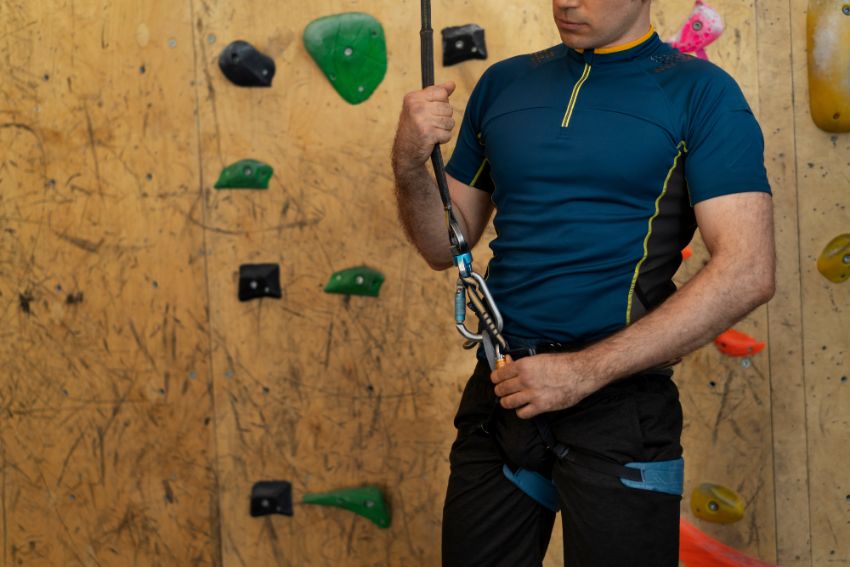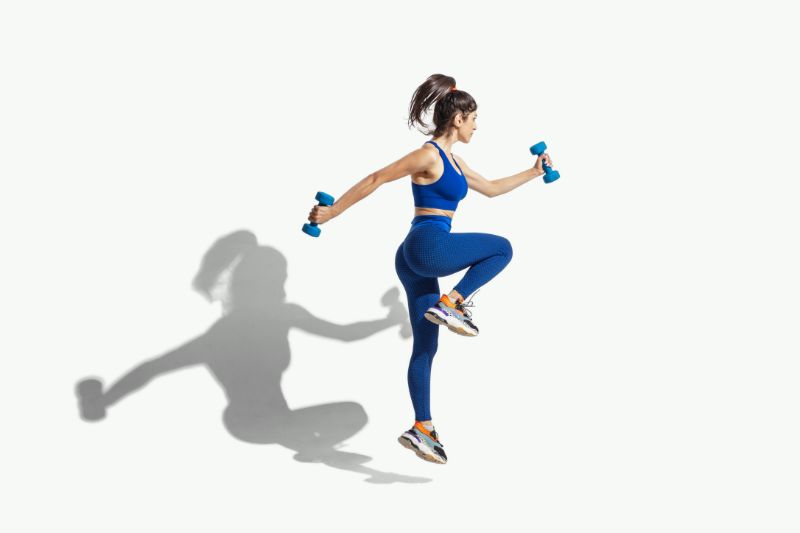Mountain climbers are a comprehensive exercise that targets multiple muscle groups including the core, arms, and legs, and also aids in improving cardiovascular fitness. Proper technique is crucial in executing mountain climbers to maximize their benefits and minimize the risk of injury.
In performing mountain climbers, one should start in a plank position, ensuring the back is flat and the hands are positioned directly under the shoulders. The exercise involves alternately pulling the knees towards the chest without lifting the hips excessively. It is important to maintain a steady, controlled pace to effectively engage the core muscles throughout the exercise.
Common mistakes in this exercise include sagging of the hips, placing the hands too far forward, and erratic movements, all of which can reduce the efficacy of the workout and increase the risk of strain. To prevent these issues, it is advisable to focus on maintaining proper alignment and a smooth motion.
Variations of mountain climbers can be introduced to adjust the difficulty level or target different muscle groups more specifically. For instance, adding a twist by bringing the knee toward the opposite elbow can engage the oblique muscles more intensely, while increasing the speed can enhance the cardiovascular challenge.
In conclusion, mountain climbers, when performed correctly, are an effective exercise for strengthening several key muscle groups and improving cardiovascular health. It is essential to adhere to proper form to ensure safety and effectiveness in the workout.
Understanding Mountain Climbers
Mountain climbers are a compound exercise that engages multiple muscle groups simultaneously, including the core, shoulders, and legs. This exercise is performed in a plank position and involves alternating knee movements toward the chest, mimicking a running motion. This action provides both strength training and cardiovascular benefits, making it a practical choice for those seeking to enhance fitness efficiently.
The exercise primarily targets the abdominal muscles, promoting core strength. Additionally, the shoulders and legs are actively engaged, contributing to overall body conditioning. The incorporation of a cardiovascular component through rapid movement helps increase heart rate, which can be beneficial for improving cardiovascular health.
Proper technique is crucial in performing mountain climbers to prevent injury and maximize the effectiveness of the exercise. A flat back and engaged core are important to maintain stability and support the spine during the exercise. It’s recommended to perform the movements at a controlled pace to ensure that the form is correct throughout the exercise.
Health Benefits of the Exercise
Mountain climbers are a compound exercise that targets multiple muscle groups including the abdominals, shoulders, and quadriceps, offering a comprehensive workout. Here are the primary benefits of this exercise:
- The activity increases cardiovascular endurance, which is essential for calorie burning and weight management.
- Performing mountain climbers regularly can enhance agility and coordination due to the dynamic movement of alternating feet.
- This exercise significantly engages the core muscles, providing stabilization and strength to the abdominal region.
- Mountain climbers are considered a high-intensity exercise with a lower impact on joints compared to other high-impact activities, making it suitable for improving athletic capabilities while reducing the risk of joint discomfort.
Step-by-Step Mountain Climbers Guide
Having explored the advantages of mountain climbers, it’s important to understand the correct technique for this exercise. Begin in a high plank position, ensuring your hands are aligned under your shoulders and your body maintains a straight line. This position serves as the foundation for the exercise.
Engage your core and draw one knee towards your chest while maintaining the other leg in a straight position. This action simulates the climbing motion, hence the name ‘mountain climbers’.
It is crucial to alternate legs with precision and control. Stability of the body is essential to avoid any unnecessary strain and to enhance the efficacy of the exercise.
Continuous, controlled movements help in maintaining the correct form throughout the exercise, which is vital for achieving the intended muscle engagement and cardiovascular benefits. This approach not only increases the exercise’s effectiveness but also minimizes the risk of injury.
Common Mistakes to Avoid
When executing mountain climbers, it’s essential to avoid certain common errors to maintain the effectiveness of the exercise and reduce the risk of injury. Here are some errors to avoid:
- Incorrect body alignment such as arching the back or excessively raising the hips can lead to discomfort and diminish the effectiveness of the exercise.
- Improper hand placement or allowing the hands to drift behind the shoulders can disrupt balance and reduce core stability.
- Failing to adequately drive the knee towards the chest can result in not fully capitalizing on the cardiovascular and muscular benefits of the exercise.
- Executing the movements too rapidly can lead to a loss of proper form, which is crucial for ensuring that the core muscles are appropriately engaged and that the exercise is being performed safely.
Maintaining correct form and pace during mountain climbers is critical for achieving the desired fitness outcomes and avoiding injuries.
Advanced Mountain Climber Variations
Once you’re comfortable with the basic form of mountain climbers, you can explore more complex variations to enhance your workout regimen.
Cross-body mountain climbers are designed to engage the obliques and facilitate core rotation, which can help in improving overall core strength.
Side-to-side mountain climbers are useful for developing agility and coordination, as they require lateral movement that challenges these aspects.
Spiderman mountain climbers focus on the hip flexors and glutes, offering a more comprehensive engagement of the lower body and core.
One-legged mountain climbers are beneficial for improving balance and stability, as performing the exercise on one leg increases the demand on the body’s stabilizing muscles.
Using sliders for mountain climbers introduces a component of resistance, which can further engage the muscles and make the exercise more challenging.
It’s crucial to prioritize proper form with these variations to prevent injury and ensure the effectiveness of the workout.
Safety Tips and Precautions
To conduct a mountain climbers exercise safely and effectively, it’s crucial to adhere to specific precautions. These guidelines are designed to minimize the risk of injury and enhance the effectiveness of the workout:
- Hand Placement: Positioning the hands directly under the shoulders is essential for maintaining balance and avoiding undue strain on the wrists.
- Core Engagement: Activating the core muscles throughout the exercise is important for protecting the lower back and improving the efficiency of the movement.
- Hip Alignment: Keeping the hips aligned with the shoulders helps ensure proper body form, which is critical for protecting the lower back.
- Breath Control: Managing breathing can aid in maintaining focus and supplying the muscles with adequate oxygen during the exercise.
- Pace: Starting the exercise at a slow pace is advisable. Increasing the speed can be considered as one builds strength and endurance over time.
These practices are based on principles of biomechanics and exercise physiology and are recommended to prevent common injuries associated with high-intensity exercises like mountain climbers.
Incorporating Mountain Climbers Into Workouts
Mountain climbers are a versatile exercise that can be integrated into various workout routines to enhance cardiovascular fitness and engage multiple muscle groups. When included in a high-intensity circuit for periods such as 30 seconds, mountain climbers contribute effectively to cardiorespiratory endurance. Additionally, incorporating them into a Tabata routine can help increase caloric expenditure and provide a comprehensive workout targeting several body areas.
For those integrating strength training with cardiovascular exercise, interspersing mountain climbers between strength sets can maintain an elevated heart rate, potentially improving aerobic capacity while facilitating fat burning. When used as part of a full-body High-Intensity Interval Training (HIIT) workout, mountain climbers can help in achieving a balanced exercise session that stimulates both upper and lower body muscles, including the core.
Specifically targeting the core, combining mountain climbers with planks can create a challenging workout that focuses on abdominal strength and stability. It’s crucial, however, to ensure proper form and adequate warm-up to avoid injuries and maximize the benefits of the exercise. Correct execution of mountain climbers involves maintaining a straight back and engaging the core throughout the movement to protect the spine and enhance muscle engagement.
Success Stories and Testimonials
Mountain climbers are a common component of fitness regimens and are often recognized for their role in improving physical fitness. According to numerous accounts, this exercise is beneficial for enhancing core strength and endurance.
- Testimonials indicate that regular incorporation of mountain climbers can assist in developing abdominal muscles and toning body muscles, which can contribute to better body composition.
- Many individuals have reported improvements in cardiovascular health, suggesting that mountain climbers can be effective in increasing heart rate and stamina.
- Feedback often includes mentions of improved agility and overall physical performance, reflecting the exercise’s ability to engage multiple muscle groups simultaneously.
- Some users have noted an increase in metabolic rate, which might support weight management efforts.
Additional Resources and Tips
To improve your technique in performing mountain climbers, consider utilizing online tutorials. These tutorials often provide a detailed breakdown of the exercise, helping to identify and correct common errors. They may also offer variations, such as modified versions of mountain climbers, which can be useful for beginners or those with physical limitations.
Engaging a certified personal trainer can be beneficial for receiving personalized feedback and ensuring that the exercise is executed properly and safely. Trainers can tailor advice to your specific needs and help prevent injury.
To enhance cardiovascular fitness, it’s advisable to integrate mountain climbers gradually into your exercise regimen. Tracking progress through fitness applications can be useful in monitoring improvements and setting realistic goals.
It is important to remember that increasing cardiovascular endurance requires consistent effort over time. Avoid excessive intensity in early stages to reduce the risk of injury.
Proper hydration and a balanced diet are essential to maintain energy levels and facilitate recovery after workouts. Maintaining these practices will support overall health and fitness development.
Conclusion
Mountain climbers are a highly effective exercise that targets multiple muscle groups including the core, shoulders, arms, and legs, making them a beneficial addition to any fitness regimen.
Proper form is crucial to ensure the exercise is performed safely and effectively. It’s recommended to incorporate variations of mountain climbers to continually challenge the body and prevent plateauing in physical progress.
Regular practice of this exercise can lead to improvements in cardiovascular fitness, muscle strength, and endurance. For optimal results, it’s advisable to integrate mountain climbers into a well-rounded workout routine.
Continuous performance of mountain climbers, with an emphasis on maintaining correct form, can significantly contribute to one’s overall fitness and health goals.
More info:


